Polygonatum, Soloman’s Seal, Yu Zhu 玉竹Sigillum SalomonisYu Zhu (TCM) Ra mnye ར་མཉེ (Tibetan) Polygonatum sibiricum, Siberian Soloman’s Seal, Huang Jing 黄精 |

|
Huang Jing (TCM)
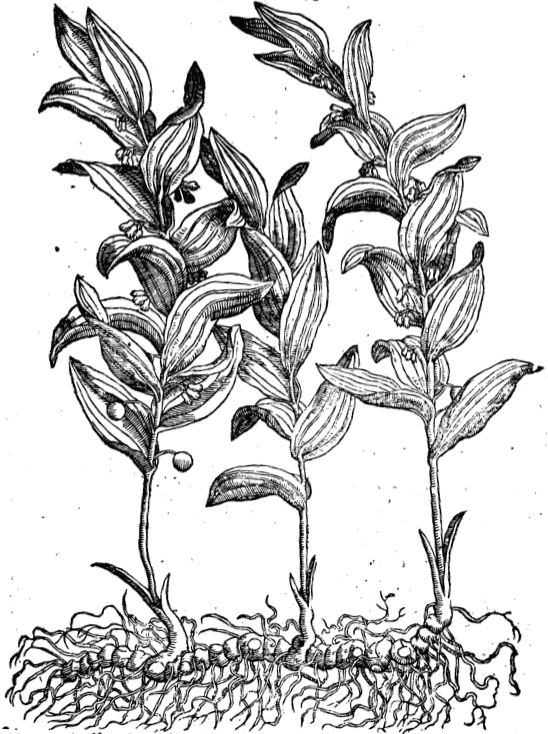 New Kreuterbuch, Matthiolus, 1563
New Kreuterbuch, Matthiolus, 1563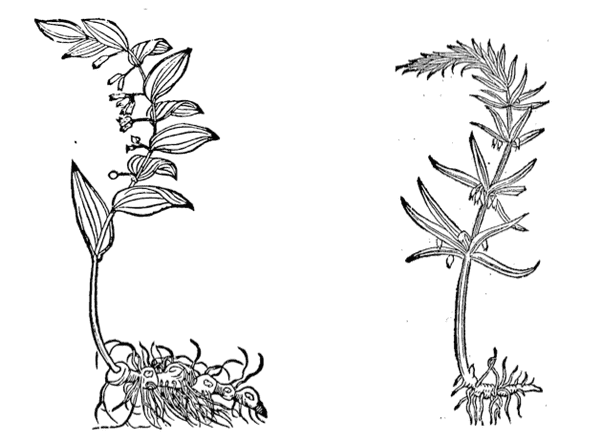 Official Soloman’s Seal Narrow-leaved Soloman’s Seal
Official Soloman’s Seal Narrow-leaved Soloman’s SealTurners Herbal, 1551 Dioscorides Materia Medica, Ruellio, 1549
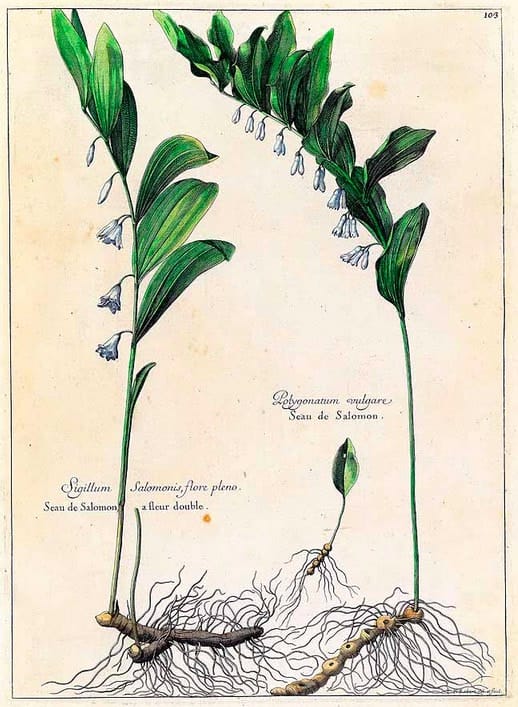 P. multiflorum
P. multiflorumDodart, Recueil des plantes gravées par ordre du roi Louis XIV, 1788
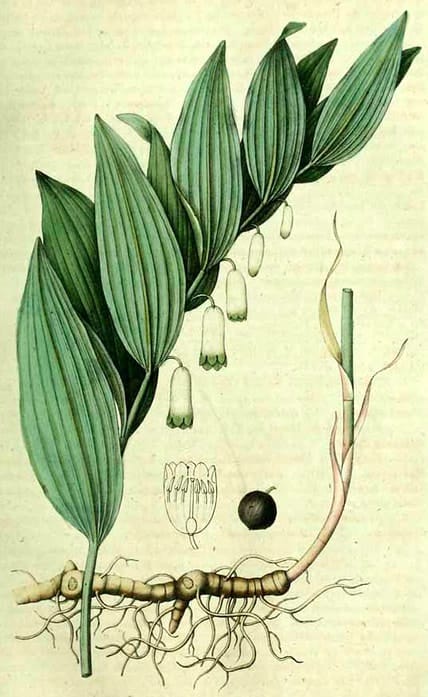
|
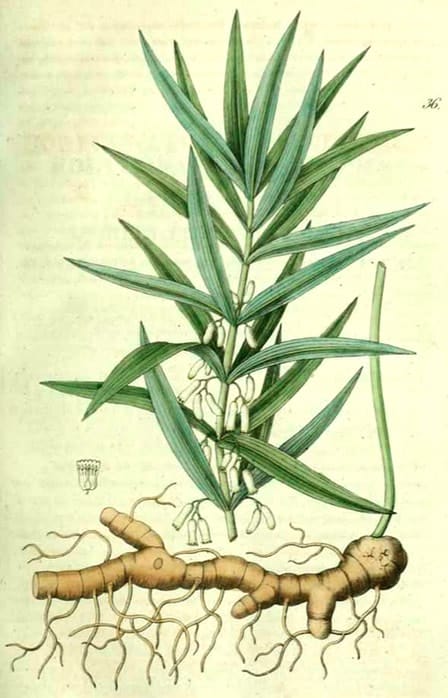
|
Dietrich, Flora regni borussici, 1832-1833
 Members CLICK HERE for the PRO VERSION
Members CLICK HERE for the PRO VERSIONBotanical name:
Polygonatum spp.
Broad and narrow-leaved varieties were known:
1. Broad-leaved (Regular or Official) Solomans Seal:
i. P. multiflorum
ii. P. odoratum
iii. P. officinale (syn. P. vulgare, P. unifolium) is said to be no longer (or less commonly) used.
2. Narrow-leaved Soloman’s Seal:
i. P. verticillatum and others (see below).
TCM uses 2 varieties of Polygonatum:
1. Yu Zhu (Broad-leaf variety):
i. P. odoratum (syn. P. latifolium, P. majus)
ii. P. inflatum
iii. P. pratti
2. Huang Jing (Narrow-leaf variety, ‘Siberian Soloman’s Seal’):
i. P. sibiricum
ii. P. verticillatum
iii. P. kingianum
iv. P. cyrtonema
The former is synonymous with P. officinale. The latter is a narrow-leaved variety and is synonymous with the narrow-leaved variety recognised in Europe.
P. biflorum is the American Soloman’s Seal with similar properties to the European variety.
Parts used:
Root
Temperature & Taste:
Temperate; ‘of a mixed temper’. Cool, moist. Sweet
Classifications:
2F. PURIFYING. 2G. CLEANSING. 2O. ASTRINGENTS. 2T. GLUTINATE
3M. ARTHRITICS
4k. ARTHRITIC
Uses:
OFFICIAL SOLOMAN’S SEAL (Yu Zhu):
1. Nourishes Yin, Generates Fluids:
-Lung Yin deficiency (dry) Cough, Bronchitis, Consumption (TCM, West)
-Stomach Yin deficiency with dry mouth, thirst
-Diabetes; Wasting
-‘all types of consumptive diseases’. (Li Shi Zhen)
2. Settles Wind, Moistens Sinews, Strengthens the Bones:
–rheumatism, arthritis, lower back pain and nephritis (TCM, West)
-Fractures, dislocations: important herb for healing fractures in the West
3. Moves the Blood, Benefits the Heart:
-‘reliable means to separate coagulated blood’. (Haller, Medicin. Lexicon, 1755)
–Heart failure; Myocardial ischemia; Coronary Heart disease; Angina Pectoris
-Headache and restlessness (Zhen Quan)
4. Tonifies Qi:
-‘reinforces Qi’ (Xiao Bing); ‘replenishes Qi in the Five Viscera’ (Heart, Lungs, Liver, Spleen, Kidney) (Chen Cang Qi)
-‘makes the person feel happy and able to enjoy a long life’ (Chen Cang Qi)
5. Clears Heat, Resists Poison:
-‘Febrile diseases caused by Wind-Heat with fever’ (Li Shi Zhen)
–‘treats epidemic febrile diseases with mania’ (Da Ming)
-‘epidemic diseases with chills and fevers’ (Zhen Quan)
6. Externally:
-Gout, Arthritis, Rheumatism, Limb pain, chew the root and apply topically; or in poultices, plasters or ointments
-very beneficial applied to Dislocations and Fractures
-Distilled Water has been much used as a cosmetic (since the time of Galen)
-applied to Spots, Scars, Scabs, Marks and even Pock marks of the skin (West, TCM)
-externally for Freckles, Sun Burn, Morphew, Scabs and the rash of Measles and Small Pox.
-good application to Boils, Sores, Carbuncles, Furuncle as well as various forms of skin irritation.
-strong wash is used for Lice and Knits of the hair.
-Bruises, Hematoma, Ecchymoses
NARROW-LEAVED SOLOMAN’S SEAL (Huang Jing)
1. Tonifies the Spleen, Benefits Qi:
–debility after prolonged illness, and used as a restorative in chronic wasting disease.
-used for Deficiency of the Qi and Blood.
2. Nourishes Yin
-Lung Yin deficiency (dry) Cough, Bronchitis, Consumption (TCM, West, Tibet)
-Stomach Yin deficiency with dry mouth, thirst
-Diabetes; Wasting
Dose:
Powder: 1–3 grams
Comment:
… available in PRO version
Substitute:
… available in PRO version
Preparation:
… available in PRO version

Main Combinations:
1. Consumption; Female weakness (Leukorrhea or excess Menstruation); Fractures, Dislocations and chronic joint disease, and for Hernia and Wounds, combine Soloman’s Seal with … available in PRO version
2. Hernia, Ruptures:
i. Soloman’s Seal with … available in PRO version
ii. Soloman’s Seal with … available in PRO version
iii. Soloman’s Seal with … available in PRO version
3. Trauma and Wounds, Soloman’s Seal with … available in PRO version
4. As a cosmetic, Soloman’s Seal … available in PRO version
TCM:
1. Stomach Yin deficiency with dry mouth and throat, Polygonatum Yu Zhu with … available in PRO version
2. Diabetes, Polygonatum Huang Jiang with … available in PRO version
3. Weakness, debility, Polygonatum Huang Jing with … available in PRO version.
TIBETAN:
1. Female weakness, Infertility, Soloman’s Seal with … available in PRO version
Major Formulas:
Infusion for Hernia
Decoction of Comfrey and Solomans Seal
Decoction for Hernia
Vulnerary Decoction
Powder for Hernia (Pharmacopoeia Extemporanea)
Cardamon 7 (Sug smel 7) (Tibetan Medicine)
Cautions:
1. Not suitable for use in cases with excess Phlegm or Damp
2. Consumption of the berries has resulted in fatalities in children. (Gessner, The Poison and Medicinal Plants of Central Europe)
Main Preparations used:
Distilled Water
